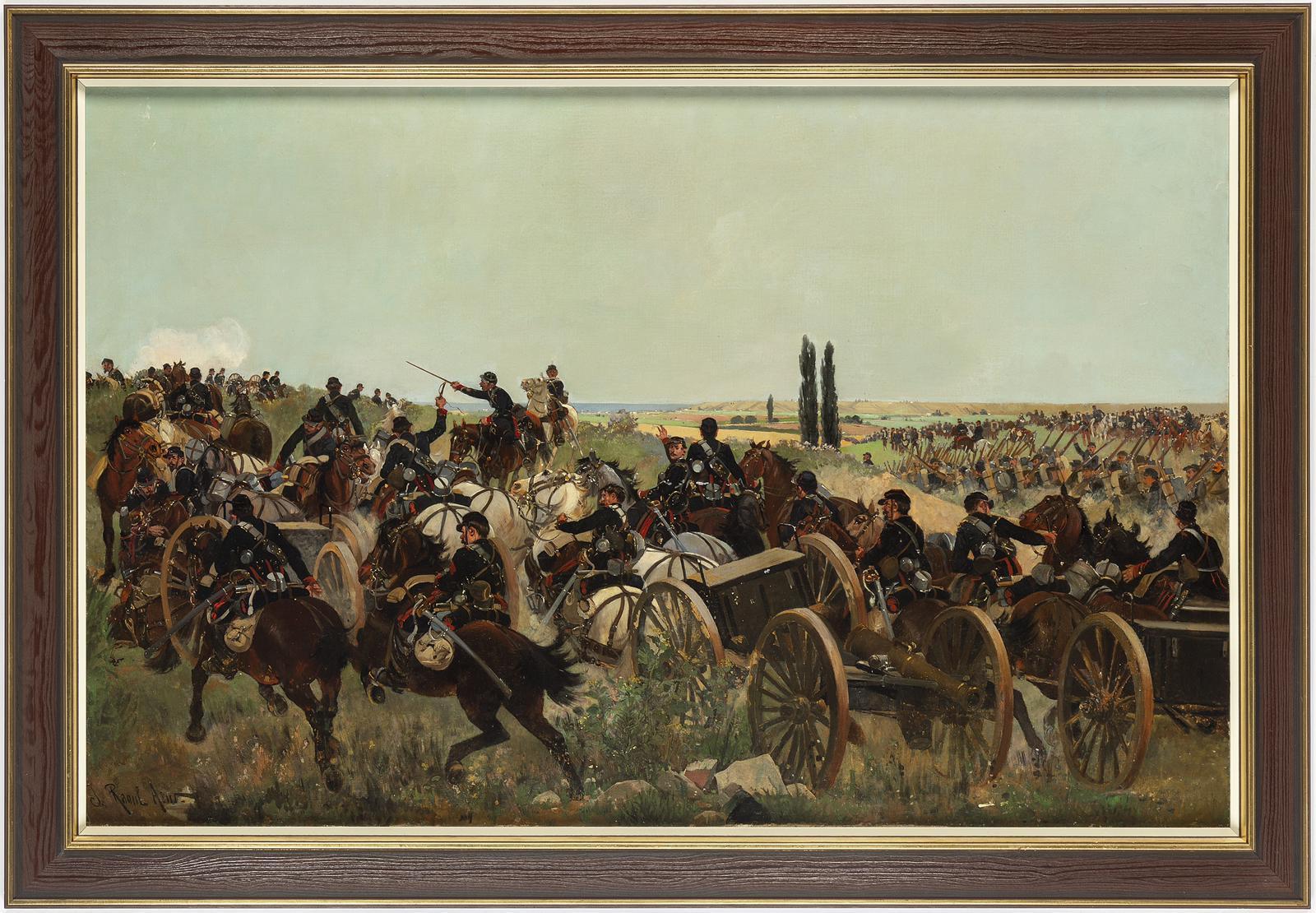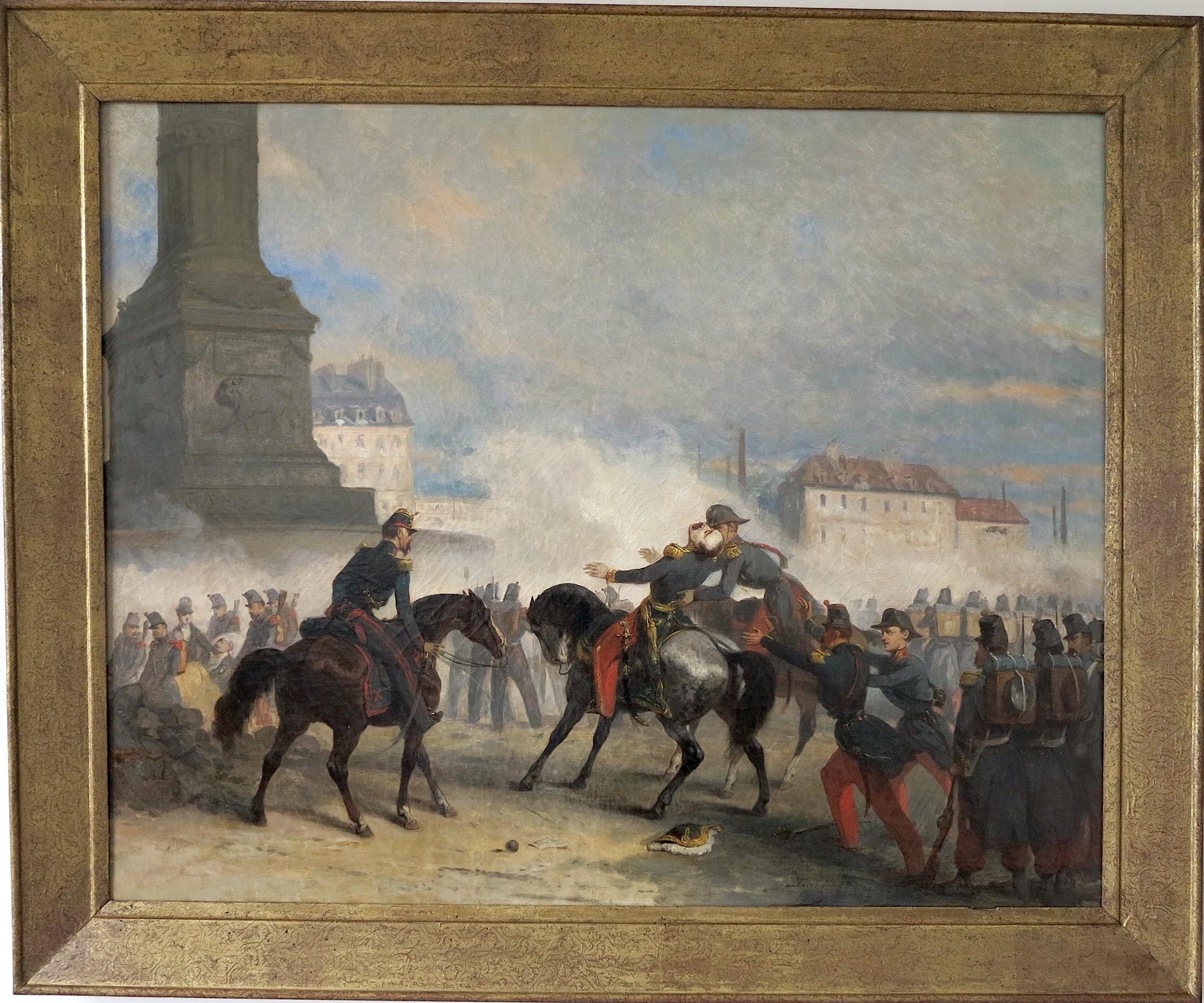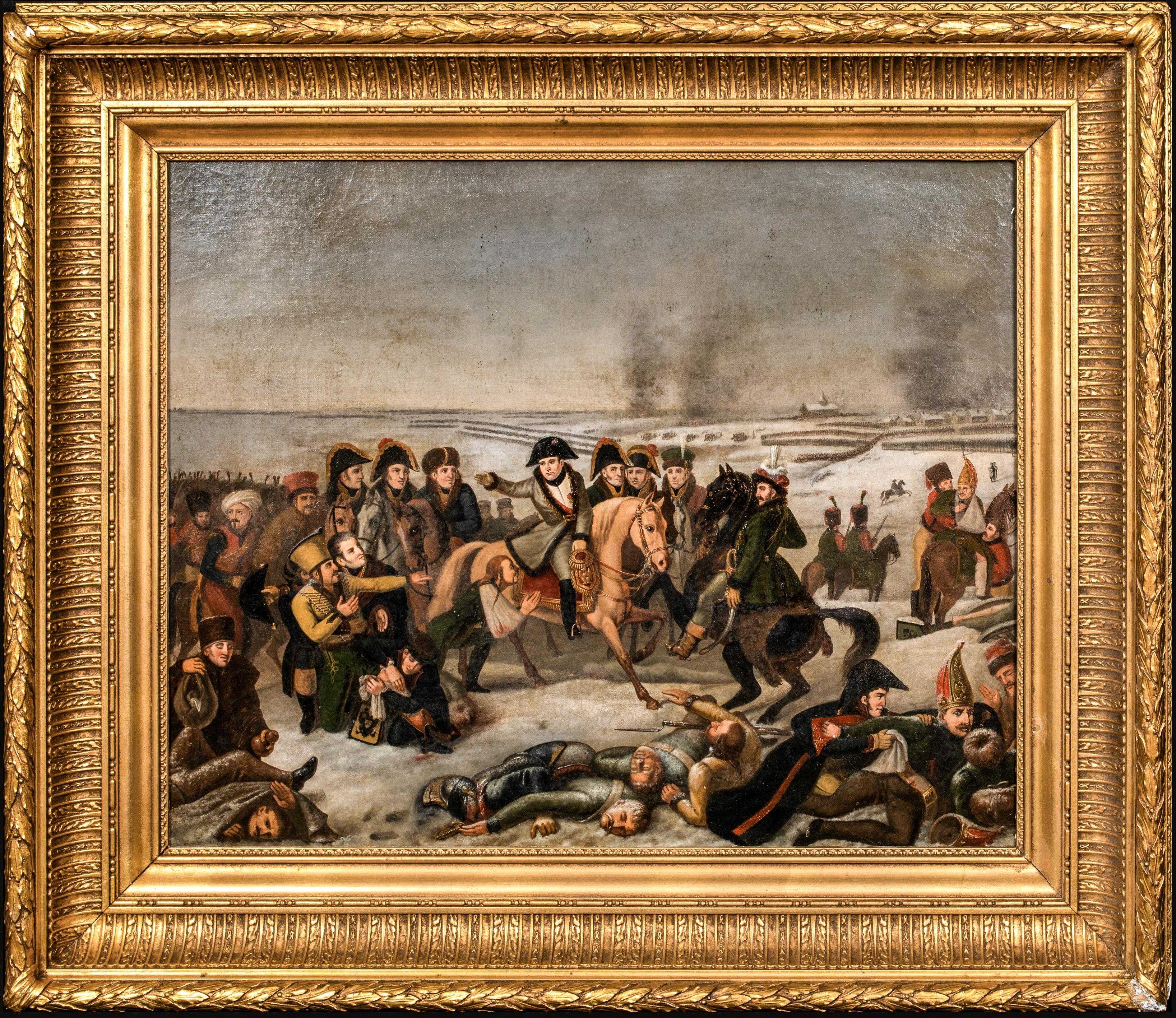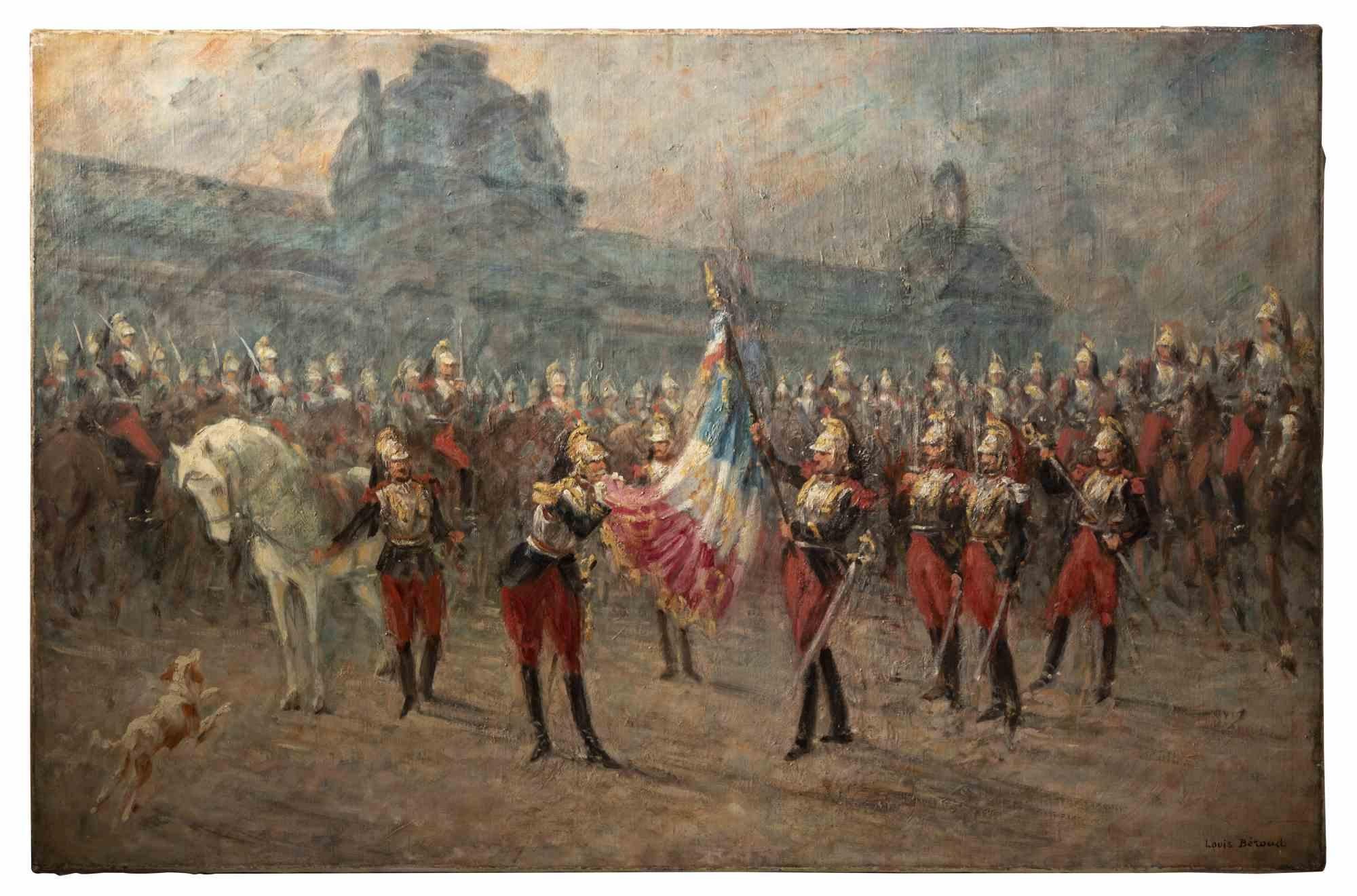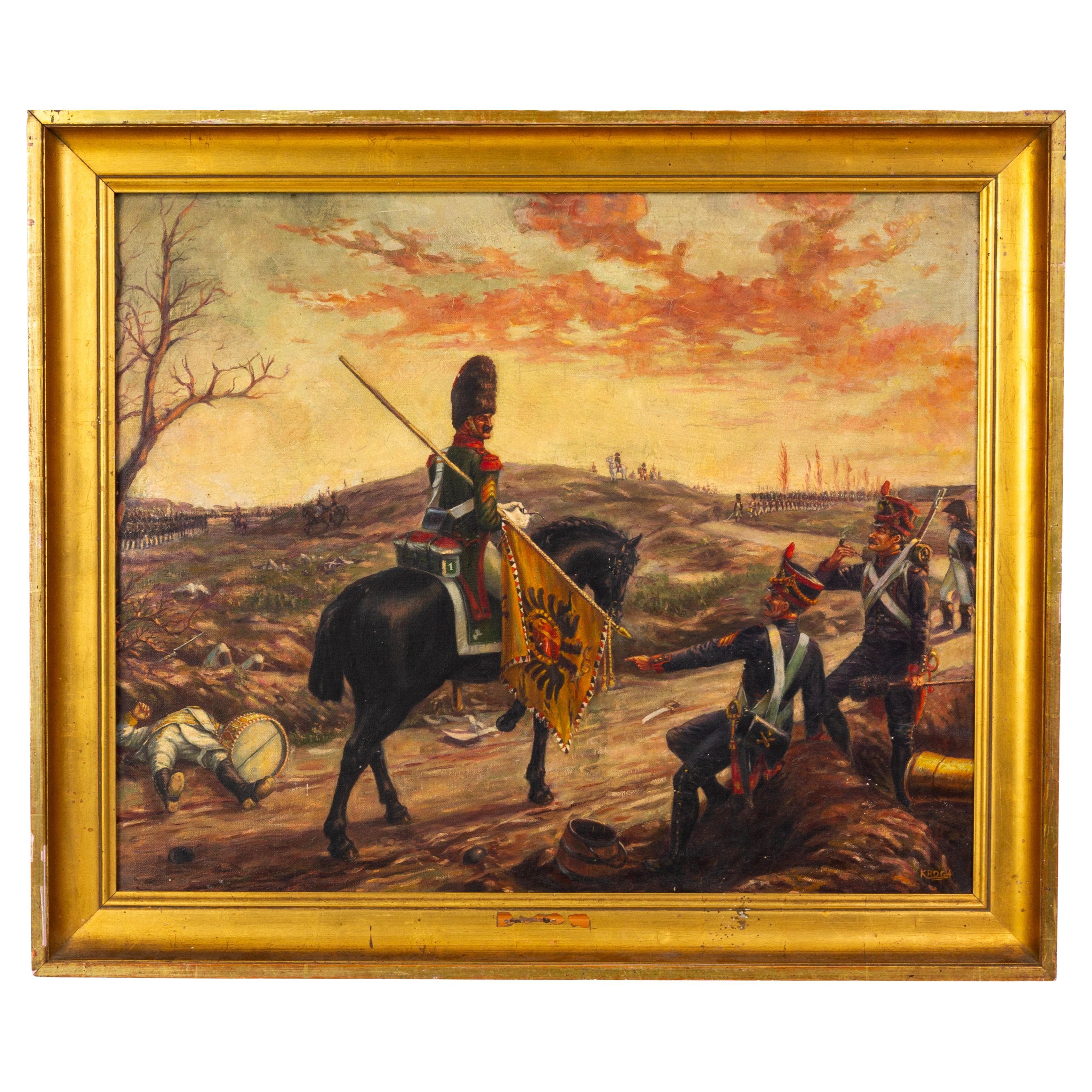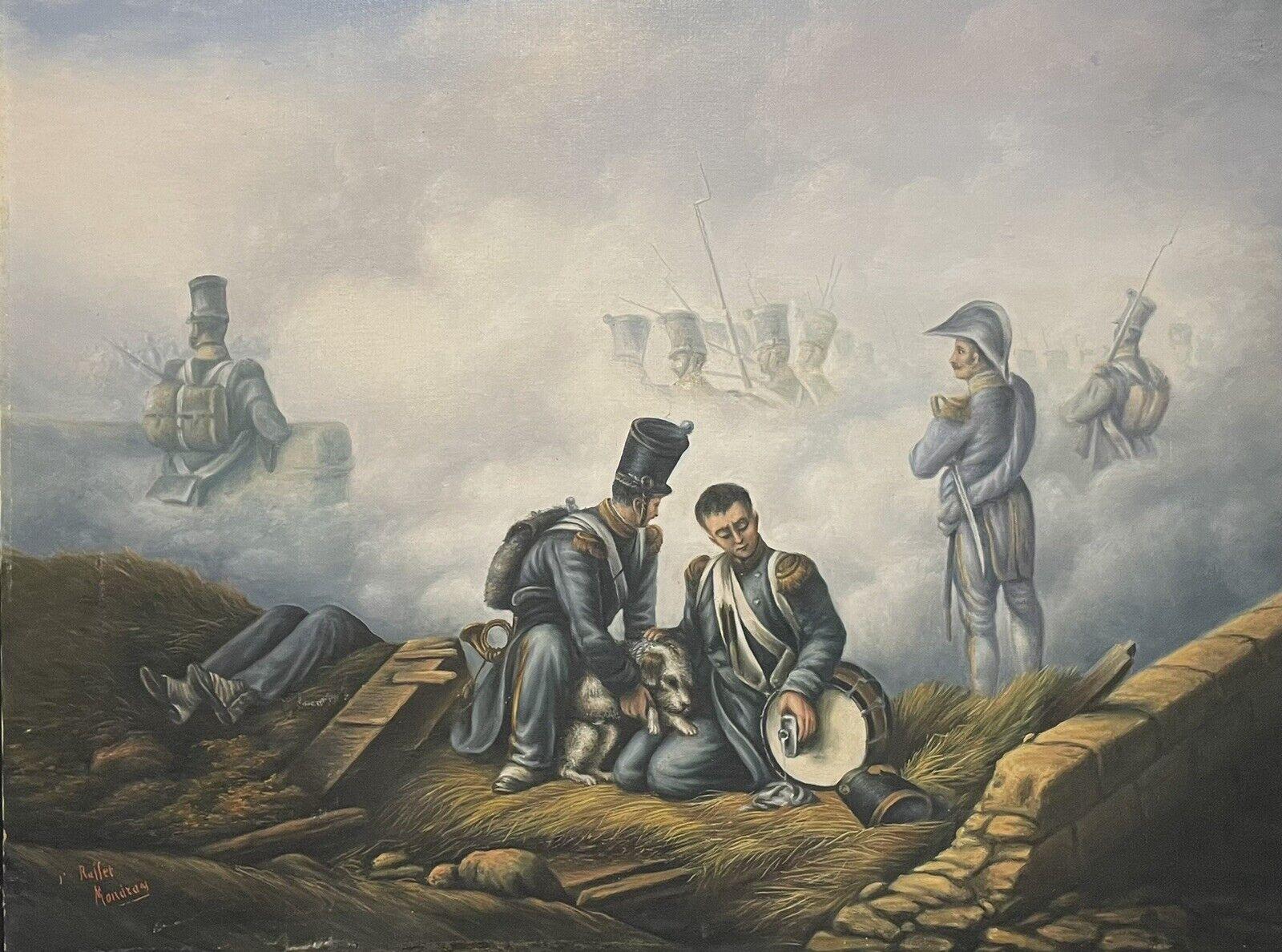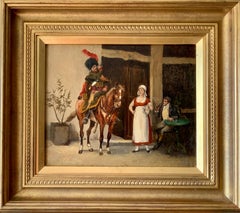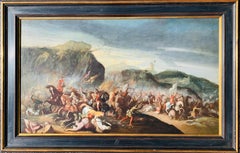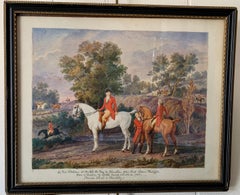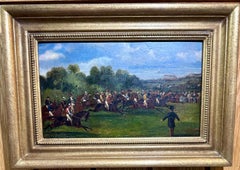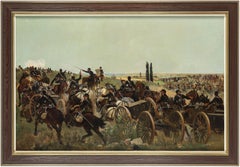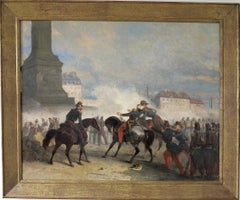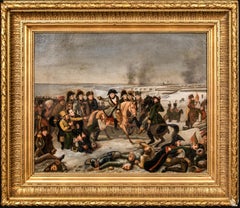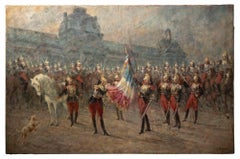Items Similar to 19th century French, Surrender of the French at Huningen Fort to the Austrians
Want more images or videos?
Request additional images or videos from the seller
1 of 17
19th century French, Surrender of the French at Huningen Fort to the AustriansCirca 1890
Circa 1890
$7,600
$24,50068% Off
£5,772.82
£18,609.7568% Off
€6,652.25
€21,444.7468% Off
CA$10,702.68
CA$34,502.0768% Off
A$11,865.51
A$38,250.6468% Off
CHF 6,235.79
CHF 20,102.2168% Off
MX$145,214.33
MX$468,125.1568% Off
NOK 77,878.63
NOK 251,056.1168% Off
SEK 73,096.89
SEK 235,641.2868% Off
DKK 49,654.89
DKK 160,071.7068% Off
About the Item
Wonderful French period copy of the famous painting by Jean-Baptiste Édouard Detaille, which the original is now in a museum in Paris.
This piece came from a private collection in New Jersey where it had been since it was purchased in France back in the 1950s. The previous owner was an Art dealer in NYC during the 1950s-70s and she kept some of her favorite paintings, this being one of them.
The piece was re-framed in the 1990s
In 35 years of dealing in paintings, I have never seen another example of this scene, it is very rare.!
History of the scene:
In the Siege of Hüningen (27 November 1796 – 1 February 1797), the Austrians captured the city from the French. Hüningen is in the present-day Department of Haut-Rhin, France. Its fortress lay approximately 2.5 miles (4.0 km) north of the Swiss city of Basel and .5 miles (0.80 km) north of the spot where the present-day borders of Germany, France, and Switzerland meet. During the time of this siege, the village was part of the Canton of Basel City and the fortress lay in an area contested between the German states and the First French Republic.
The siege occurred within the French Revolutionary Wars during which Revolutionary France ranged itself against a Coalition that included most of the states with which it shared land or water borders. In particular, France was at odds with the European monarchies, who initially feared for the safety of Louis XVI and his wife, who was the sister of the Holy Roman Emperor. Fighting, which began in 1792, had been inconclusive. Fighting in 1795 had largely favored the Coalition; the Campaign in the Rhineland in 1796, though, had pushed the Coalition forces far into the German states; the Coalition forces had pushed back and, at the end of the summer's fighting in 1796, the Austrian force under command of Archduke Charles had succeeded in pushing the French back to the Rhine.
With the conclusion of the Battle of Schliengen on 24 October, the French army withdrew south and west toward the Rhine. Forces commanded by Jean Charles Abbatucci and Pierre Marie Barthélemy Ferino provided the rear guard support and the main force retreated across the Rhine into France. The French retained control of the fortifications at Kehl and Hüningen and, more importantly, the tête-du-ponts (bridgeheads) of the star-shaped fortresses where the bridges crossed the Rhine. The French chief commander, Jean-Victor Moreau, offered an armistice to the Austrian commander, which the archduke was inclined to accept. He wanted to secure the Rhine crossings and then send troops to northern Italy to relieve Dagobert Sigmund von Wurmser at besieged Mantua; an armistice with Moreau would allow him to do that. However, his brother, Francis II, the Holy Roman Emperor, and the civilian-military advisers of the Aulic Council categorically refused such an armistice, forcing Charles to order simultaneous sieges at Kehl and Hüningen. These tied his army to the Rhine for most of the winter. He himself moved north with the bulk of his force to invest the larger crossing at Kehl, and instructed Karl Aloys zu Fürstenberg to conduct the siege in the south by Basel. While the Austrians besieged these Rhine crossings, Moreau had sufficient surplus troops to send 14 demi-brigades (approximately 12,000 troops) into Italy to assist in the siege at Mantua.[1]
Fürstenberg's force initiated the siege within days of the Austrian victory at the Battle of Schliengen. Most of the siege ran concurrently with the siege at Kehl, which concluded on 9 January 1797. By the time troops engaged at Kehl marched to Hüningen in preparation for a major assault, Fürstenberg had established extensive earthworks, and built three large batteries that rained continuous cannonades into the fortress. The Habsburgs repelled a French sortie in early December in which Abbatucci, the French commander, was killed. His replacement, Georges Joseph Dufour, capitulated on 1 February 1797, preventing a costly assault, and the French evacuated, taking everything of value that remained with them. At the conclusion of the siege at Hüningen, the Austrians took possession of a pile of rubble.
- Creation Year:Circa 1890
- Dimensions:Height: 59 in (149.86 cm)Width: 46 in (116.84 cm)
- Medium:
- Movement & Style:
- After:Jean-Baptiste Édouard Detaille (1848 - 1912, French)
- Period:
- Condition:The painting is in original untouched condition. It has no restoration and is ready to hang.
- Gallery Location:Woodbury, CT
- Reference Number:1stDibs: LU50738491482
About the Seller
5.0
Platinum Seller
Premium sellers with a 4.7+ rating and 24-hour response times
Established in 1983
1stDibs seller since 2016
507 sales on 1stDibs
Typical response time: <1 hour
- ShippingRetrieving quote...Shipping from: Woodbury, CT
- Return Policy
Authenticity Guarantee
In the unlikely event there’s an issue with an item’s authenticity, contact us within 1 year for a full refund. DetailsMoney-Back Guarantee
If your item is not as described, is damaged in transit, or does not arrive, contact us within 7 days for a full refund. Details24-Hour Cancellation
You have a 24-hour grace period in which to reconsider your purchase, with no questions asked.Vetted Professional Sellers
Our world-class sellers must adhere to strict standards for service and quality, maintaining the integrity of our listings.Price-Match Guarantee
If you find that a seller listed the same item for a lower price elsewhere, we’ll match it.Trusted Global Delivery
Our best-in-class carrier network provides specialized shipping options worldwide, including custom delivery.More From This Seller
View AllA French Chasseur a Cheval de la Garde Imperiale, drinking outside a Inn or Pub
By Frank Moss Bennett
Located in Woodbury, CT
A French Chasseur a Cheval de la Garde Imperiale, drinking outside an Inn or Pub.
Frank Moss Bennett was born in Liverpool, England on 15 November 1...
Category
1890s Victorian Figurative Paintings
Materials
Oil, Canvas, Panel
$3,000 Sale Price
20% Off
Free Shipping
17th century Italian Horse Battle scene between Crusaders and their enemy
By Jacques Courtois
Located in Woodbury, CT
Fine huge 17th Century Italian/French Old Master Battle Scene of the Crusades, oil on canvas. Grand scale extensive landscape view of a battle from the 1670-80 period, with cavalry f...
Category
Late 17th Century Old Masters Figurative Paintings
Materials
Oil
$15,600 Sale Price
20% Off
Free Shipping
19thC portrait of the Duc De Chartres and Louis Philippe with their horses
Located in Woodbury, CT
Well painted late 19th century watercolor of the Duc De Chartres and Louis Philippe with their horses out Fox hunting.
The piece is a fine quality watercolor, well framed in an Eng...
Category
1890s Victorian Portrait Paintings
Materials
Watercolor
19th century English landscape with Horse Racing, Possibly the Epsom Derby
By Samuel Henry Alken
Located in Woodbury, CT
Samuel Henry Alken (1810–1894)
Horse Racing Scene, Possibly the Epsom Derby
Oil on board, unsigned
Attributed, English school circa 1840
Presented in a later gilt frame with beaded inner edge
This dynamic mid-19th century racing scene, attributed to Samuel Henry Alken—also known as Henry Alken Junior—captures the high-stakes moment just before the thundering release of horses and riders at the starting line. A tightly packed field of brightly jacketed jockeys leans forward with urgent anticipation, the taut muscles of their mounts echoing the gathering tension. In the foreground, a race marshal gestures dramatically to signal the start, his stance underscoring the energy about to be unleashed.
Though unsigned, the work bears the unmistakable hallmarks of Samuel Henry Alken’s hand: vigorous composition, attention to equine form, and a sharp eye for the choreography of sport. The figures are finely modelled, the palette lively but grounded, and the setting—with its wooded backdrop, animated crowd, and distant grandstands—suggests a major 19th-century race meeting, possibly the Epsom Derby, a subject Alken is known to have returned to in several formats.
The composition’s panoramic sweep and low horizon lend a cinematic quality, while the density of detail—each silken cap and coat, each bridle and plume—evokes the pageantry and social theatre of Britain’s sporting calendar at the height of its Regency and early Victorian splendour.
A rare and spirited scene from the golden age of English sporting painting...
Category
1840s Victorian Figurative Paintings
Materials
Oil, Board
German oil painting, Figures in an interior/barn playing, 19th century, Antique
Located in Woodbury, CT
Well painted late 19th-century German genre painting. Often painted in the Munich area of Germany these highly desirable antique paintings are always of t...
Category
1890s Victorian Figurative Paintings
Materials
Oil, Wood Panel
$1,720 Sale Price
20% Off
Free Shipping
19th century British Folk Art, Singers singing about Napoleon in a landscape
Located in Woodbury, CT
Anonymous (English School)
The Ballad Singers, ca. 1820
Oil on canvas
Lively, theatrical, and brimming with charm, The Ballad Singers is a rare surviving example of early 19th-centu...
Category
1820s Folk Art Figurative Paintings
Materials
Canvas, Oil
You May Also Like
The French-Prussian War - Oil on Canvas by Raoul Arus - Late 19th Century
Located in Roma, IT
The French-Prussian War is an original modern artwork realized by the French painter Raoul-Joseph Arus in the last decades of the XIX Century.
Original Oil painting on Canvas.
Hand...
Category
Late 19th Century Figurative Paintings
Materials
Canvas, Oil
The death of General Négrier on Place de la Bastille, Paris - France
By Nicolas Edward Gabé
Located in Paris, IDF
Nicolas Edward GABE
(Paris, 1814 - Paris, 1865)
The death of General Négrier on Place de la Bastille on June 25, 1848
Oil on canvas
Signed and dated lower right
82 x 101 cm
1849
Nicolas Edward Gabé is a 19th century artist who is still little studied to this day and yet seems to have enjoyed, according to the artistic press of the time, a certain notoriety, in particular for his seascapes.
The few bibliographical elements that we have come from the Salon booklets and tell us that the artist was born in Paris in 1814, therefore shortly before the end of the Empire.
No elements on his artistic training are mentioned in the booklets, we just know that Gabé exhibited at the Paris Salon from 1835 to 1864 where he first practiced miniature then then approached easel painting, risking himself as well in still life that the seascapes, the landscape, the portrait or the hunting.
According to press articles, he also took part in various exhibitions in the provinces such as Boulogne-sur-Mer and Marseille.
Notably, Gabé did not exhibit at the Salon his large historical canvases on the revolution of 1848, which today are of obvious documentary and iconographic interest; probably for political reasons which are easily understandable to us today in view of the historical events of then.
Gabé died in Paris at the age of 51 on January 4, 1865 with a mention in the January 7, 1865 edition of L'Union des Arts: “The death of Mr. Gabé, painter, well known in the export trade in paintings as well as to the auctioneers' hotel, whose sales it supplied through its numerous navies. “
"On June 25, 1848, in front of the barricades erected in the Bastille by the insurgents of the Red Republic, General Négrier fell to death, while he was uttering words of order and conciliation". Here are the opening lines of the tribute paid by Colonel Borgarelli d´Ison, friend of General Négrier.
General Négrier belonged to a family from Maine, brought back by Marshal Lannes from emigration. Born in Le Mans on April 27, 1788, François Marie Casimir de Négrier entered, barely 18, as a volunteer in the 2nd Light Infantry Regiment. He began in 1806 with the campaigns of Prussia and Poland, during which he earned, through his bravery, the rank of sergeant and the decoration of the Legion of Honor. He made the following campaigns in Spain and Portugal, and left, with his regiment, only for the campaign of France, in 1814, after having risen successively, by actions of brilliance and by a serious wound, to the ranks of head of battalion and officer of the Legion of Honor, with which he was provided from October 1813. The Restoration retained his rank in his regiment. After having fought and wounded a second time seriously in Waterloo, Négrier was recalled in 1816 under the second Restoration. He was appointed, in 1825, lieutenant-colonel, then colonel in 1830, brigadier general in 1836, and of division in 1841. From March 1837 he participated in the conquest of Algeria.
The Revolution of 1848 found Negrier in possession of the important command of the 16th Military Division in Lille. Quaestor of the Assembly in these times which promised to be troubled, Négrier reviewed the Place de la Concorde on June 23 at around noon various mobile guard battalions. He then took the head of 2,000 men provided by the 10th and 11th legions of the national guard and bivouacked on the Place du Palais until the next day 24. On Sunday 25 at nine o'clock, the Négrier division resumed the fight towards the Saint suburb. -Antoine. The troop gains continual advantages. At around two o'clock the column of Négrier had seized the Pont Marie: it had removed the barricades from the Quai Saint-Paul, the rue de l'Etoile, the rue des Barres...
Category
Mid-19th Century French School Figurative Paintings
Materials
Oil
Napoleons Retreat From Russia, 19th Century French School Large Napoleonic Wars
Located in Blackwater, GB
Napoleons Retreat From Russia, 19th Century
French School Large Napoleonic Wars Scene
Large 19th Century French School Napoleonic Wars Scene of Napoleon retreating following the in...
Category
19th Century Portrait Paintings
Materials
Canvas, Oil
$4,930 Sale Price
20% Off
Ceremony of the Cuirassiers -Painting by L. Beraud - Early 20th Century
Located in Roma, IT
Ceremony of the Cuirassiers is an original painting realized by Louis Beraud in the Early 20th Century.
Mixed colored oil painting on canvas.
Signed on lower right.
Includes frame.
Category
Early 20th Century Modern Figurative Paintings
Materials
Oil
Large Signed Oil Painting of Franco-Austrian Napoleonic Wars 19th Century
Located in Nottingham, GB
Signed Oil Painting of Franco-Austrian Napoleonic Wars 19th Century
Dimensions: 85 x 72cm, framed.
Good condition overall
From a private collection.
Free international shipping.
Category
Antique 19th Century Paintings
Materials
Canvas, Paint
Large 19th Century French Oil Battlefield Soldiers & Wounded Dog Scene, Waterloo
Located in Cirencester, Gloucestershire
Artist/ School: French School, 19th century
Title: The Battlefield.
Medium: oil painting on canvas, unframed.
canvas: 26.75 x 35 inches
Provenance: private collection, South o...
Category
19th Century Victorian Figurative Paintings
Materials
Oil
More Ways To Browse
French Military Art
French Military Paintings
Austrian 19th Century Painting
19th Military Painting
19th Century Military Paintings
Austrian Cross
New Jersey 19th Century
Revolutionary War Antique
Antique Frames Nyc
19th Century Military Oil Paintings
New Jersey 19th Century Painting
Antique Holy Water
Swiss Guard
Painting Of Roman Emperors
Charles Rain
Francis Winter
Jean Charles Moreau
Jack Hartley
